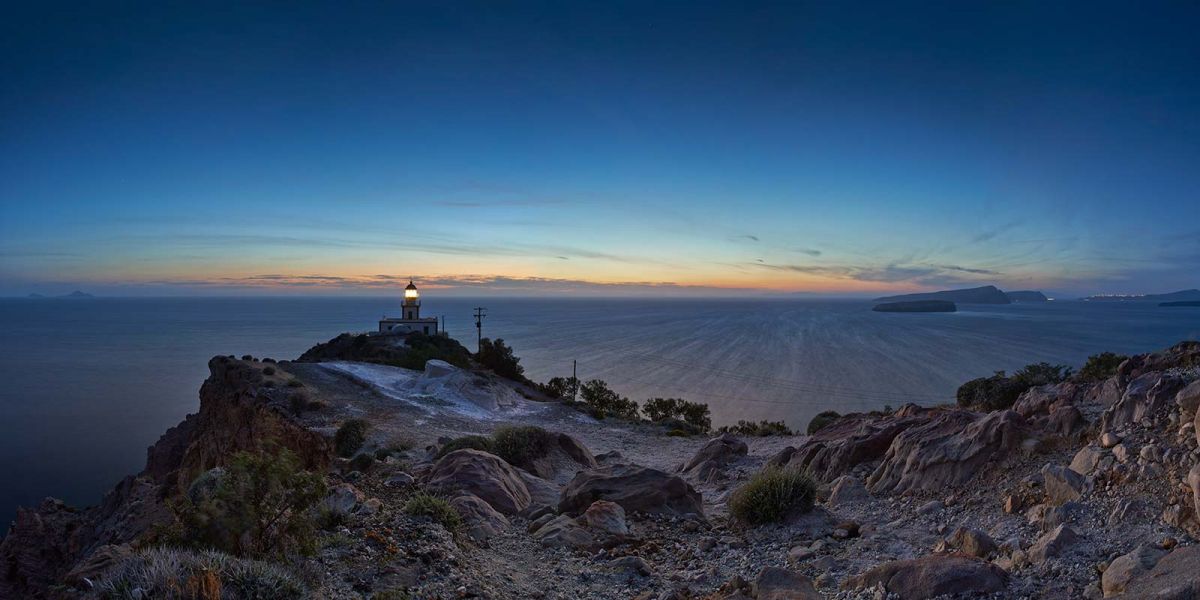CHRISTOS SIMATOS
I’ve visited Santorini many times before. Each time I discovered new vantage points from which I could observe the interplay between the light and the landmass of the island, but always in the summer. I often wondered how would the island look like in another season. I decided to visit it in spring. How different everything looked then. The island had transformed, the colours were different. The stone no longer dominated the scenery, the fully-blossomed nature did. The weather was however a real revelation. The early-morning mist, climbing up the caldera, transformed into white clouds that rushed all day over the island to rest discretely by the distant horizon, joyfully playing with the last rays of light, setting the sky ablaze. I got so anxious, so impatient to capture all these changes.
I started my little journey with the ascent of the mountain where the monastery of Prophetes Elias (Prophet Elijah) lies. Santorini is one of the few islands you can watch as a whole from its highest point; I got the same feeling as when I had visited Delos. I felt consumed by the sky, as I gazed at the land from above, being surrounded by the sea. Arriving at the site I had spotted before, far away from the road, just a few paces from the high cliff, I set up my equipment and got to work. The view was magnificent, the strong cold wind, however, reminded me that the warm summer was yet to come. I stood still for three hours, waiting, observing the changes of light, the last clouds at the horizon crossing swiftly the island. The experience was unique, only the cold wind urged me to return to my cozy home. “Just one more”, I murmured inside, “hang on for just one more take, the street lamps will light up in ten minutes”. The image that was engraved in my mind was the one of the whole of Santorini adorned with its street lamps and that last light before the night set in. It was worth waiting in the strong cold wind, in the end.
With that image of Prophetes Elias still hovering in my mind, I started the next day my descent to Athenios. From up the high mountain, down to sea level. The clouds all around were rushing to somewhere. I rolled down to the harbor, past the dock and there I found the site I was looking for. The day before, at Prophetes Elias, I had a full view of space, now I was experiencing the insignificance of human existence whenever it faces the grandiose scale of nature. The sun was blinding. There was, however, a certain serenity, of a transcendental and metaphysical nature. I was overwhelmed by the urge to create an image that would convey that sensation. The dynamics of the rocks was intense and guided your eyes to the center of the image, to the sea. Wanting to record the metaphysical substance of the water element, I chose to use long exposure times. In this way the motion of the sea disappears giving its place to a dynamic calmness, engaging the hard rocks and the seemingly serene sea. The metaphysical element reveals itself at the point where the restless water element meats the land. There are no discrete boundaries there, the mist takes over the intervening space. What surprised me was for how long a pair of asian-tourists could just stand there still, motionless, at the edge of the dock during my take. What a pleasant addition to the scenery. I stayed there till the line cruiser arrived.
I always thought the view of the sunset from the lighthouse was more substantial. There is a certain austerity. A few rocks, the sea and the sky, with the lighthouse, as an everlasting token of solitude, being the sole human intervention to the scenery. It’s a spot that confronts you with your inner self. The harshness of the rocks transforms to the hardness each one of us carries inside, the sea sometimes fierce sometimes tranquil, the sky a continuous ascent, and the lighthouse, a link bringing the sky and the earth together, its shining with the last light of day. A bright spot inside our soul that works discretely as a point of reference but also of circumvention.
The days moved fast. I methodically worked from the one site I had noticed in the past to the other taking photographs from the same spots. I once again coveted the sensation the images at Prophetes Elias and the lighthouse had offered me, but with no luck. One day, as I was walking at Imerovigli, I found myself at Skaros. I was overcome with joy, it was something I hadn’t seen the previous times, how could I have missed it…
The path leading to Skaros takes you away from the steep cliffs. Suddenly you find yourself inside the caldera, one step away from Nea Kameni. Arriving at its edge, a surprise was waiting for me. The weather conditions offered a paradox. High above, the clouds, dark and heavy, ready to drench everything in rain confronted the unduly serene waters of the caldera. A total serenity in contrast with an imminent winter storm, and in the middle there was a rock, as a paleolithic sculpture uniting these two contradicting worlds. The rain finally didn’t come. In the end, the serenity of the sea tamed the uneasy sky, which by the end of the day scattered its previously thick clouds, leaving behind pale strokes of blue that joined the colorful, joyful interplay of sunlight with the coming night.
From all the times I had visited Santorini, this one was a true revelation to me. The nature, the harshness of the rocks along with fast changing weather conditions and the interplay of light with the night worked as bright beacons to a journey of inner quest, a redefinition of my relationship with the landscape.


